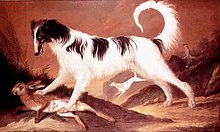Karl Kaspar Pitz
Karl Kaspar Pitz (born September 27, 1756 in Saarbrücken , † September 28, 1795 in Prague , also Kaspar, Johann Kaspar, Carl Caspar or Gaspard Pitz ) was a German painter .
Life
Karl Kaspar Pitz was born in Saarbrücken in 1756 and spent his childhood and youth there. Under the influence of Johann Christian von Mannlich , he came to Zweibrücken and was taught by him between 1774 and 1782. Pitz soon belonged to the circle of artists who frequented the court of Duke Charles II August . Satisfied with his pupil, Mannlich entrusted him with the decoration of the ceiling and the walls of the theater in Zweibrücken based on his sketches. In his memoirs, he reports: "Pitz outdid himself in these incredible landscapes. You could distinguish every type of tree, the foliage of which was done with the greatest care." Duke Charles II. August also liked the paintings so much that he noticed Pitz had his expenses undertaken study trips to France, Italy and England.
From 1782 to 1784 Pitz studied at the École des Beaux-Arts in Paris, from 1785 to 1787 at the French Academy in Rome. During his time in Rome, during which he also came into contact with Goethe , his painting style developed from playful Rococo to strict classicism . This development can be clearly seen in his sketchbook kept in the Heimatmuseum in Saarbrücken. An example of his classical style is the oil painting “ Cleopatra , the wound of the dying Antonius breastfeeding”, which enjoyed great popularity at the time. Goethe had an engraving based on this picture, made by Johann Friedrich Leypold for Johann Friedrich Frauenholz , printed in 1809 in the intelligence paper of the Jenaische Allgemeine Literatur-Zeitung No. 9. But Pitz also received criticism for the recent "stiff and cold manner" of the presentation. The counterpart to the painting Cleopatra and the dying Antonius, the death of Cleopatra, remained in the drawing.
When the French army invaded the Palatinate in the course of the French Revolution in 1793 , Pitz fled from Zweibrücken to Prague. There he died on September 28, 1795 at the age of 39, presumably from poisoned chocolate that was given to him by a jealous rival.
Johann Stanislaus Schaffroth is one of Pitz's students .
Works (selection)
- Cleopatra and the dying Antonius (Saarlandmuseum Saarbrücken)
- Portraits of Duke Karl II August von Zweibrücken and Count Palatine Friedrich Michael von Zweibrücken, counterparts (both in the Charlottenzimmer of the Munich Residence Museum)
- Portrait of Duke Karl II August von Zweibrücken (Zweibrücken Town Hall)
- Portrait of the Countess of Ottweiler (owned by Countess Schmising-Kersstenbroek in Rosnochau near Oberglogau )
- Oval portrait of Duke Karl August von Zweibrücken (State Painting Collection Speyer)
- Fun fair at a church, 1792 (permanent loan from the Bavarian State Painting Collection in the Palatinate History Museum)
- Landscape with stud horses (Speyer State Paintings Collection), 1781
- Landscape with a waterfall (Saarland Museum: Old Collection) 1783
- Advertiser in a tavern (Bayerische Staatsgemäldesammlungen), 1783, 30.4 × 108.2 cm
- Mars and Venus, surprised by the gods (State Painting Collection Speyer), 1786
- Fire of Saarbrücken Castle in 1793 (Saarlandmuseum Saarbrücken)
- Construction of the tree of freedom in Zweibrücken (Zweibrücken Local History Museum), 1793
literature
- Karl Lohmeyer: The Saarbrücken painter Kaspar Pitz. In: Saarbrücker Zeitung. No. 190, July 13, 1911.
- Berthold Roland: The painter group from Pfalz-Zweibrücken. Painter and painting of a small royal court in the 18th century. Heitz Publishing House, Baden-Baden 1959.
- Sabine Jung: Johann Caspar Pitz. In: Saarland pictures of life. Volume 4, Saarbrücken printing and publishing house, Saarbrücken 1989.
Web links
- Literature on Karl Kaspar Pitz in the Saarland Bibliography
- Artnet: Karl Kaspar Pitz
- Zweibrücken City Museum: permanent exhibition
- Pitz, Johann Kaspar. In: Saarland biographies.
Individual evidence
- ^ Lohmeyer: The Saarbrücken painter Kaspar Pitz. In: Saarbrücker Zeitung. July 13, 1911, no.190.
- ↑ Mannlich: Rococo and Revolution: Memoirs of Johann Christian von Mannlich 1741–1822. Mittler, Berlin 1913, p. 328.
- ↑ a b Dlabač: General artist lexicon for Bohemia. Georg Olms Verlag, Hildesheim 1973.
- ^ Archives Alsaciennes d'Histoire de l'Art, Peintres allemands élèves de L'Academie, 7 août 1782, Gaspard Pitz, première année, Strasbourg 1922; troisième année, Strasbourg 1924.
- ^ Catalog of the State Painting Collection in Speyer, official edition, Munich 1927, p. 64.
- ^ Lohmeyer: Johann Friedrich Dryander. In: The Cicerone. 20th year, Berlin 1928.
- ↑ a b Pitz, Kaspar . In: Hans Vollmer (Hrsg.): General lexicon of fine artists from antiquity to the present . Founded by Ulrich Thieme and Felix Becker . tape 27 : Piermaria – Ramsdell . EA Seemann, Leipzig 1933, p. 122 .
- ↑ mwn Lohmeyer: Art in Saarbrücken. In: Messages of the Rhenish Association for the Preservation of Monuments and Heritage Protection. 6th year, Düsseldorf 1912.
- ^ Nagler: New general artist lexicon. Mareis, Linz 1909.
- ^ Feulner: Catalog of the paintings in the Residenzmuseum Munich and in Nymphenburg Palace. Hugo Schmidt Verlag, Munich 1924, p. 68.
- ^ Ralph Melcher (ed.): Museum for Pre- and Early History. Old collection. Museum in the castle church. Guide to the collections. Dillingen 2009, p. 96 f.
- ↑ Fig. At Lohmeyer: The art in Saarbrücken. In: Message from the Rhenish Association of Monument Preservation and Heritage Protection. Volume 6, Issue 1, 1912, p. 39.
| personal data | |
|---|---|
| SURNAME | Pitz, Karl Kaspar |
| ALTERNATIVE NAMES | Pitz, Carl Caspar; Pitz, Gaspard; Pitz, Johann Caspar; Pitz, Kaspar |
| BRIEF DESCRIPTION | painter |
| DATE OF BIRTH | September 27, 1756 |
| PLACE OF BIRTH | Saarbrücken |
| DATE OF DEATH | September 28, 1795 |
| Place of death | Prague |




